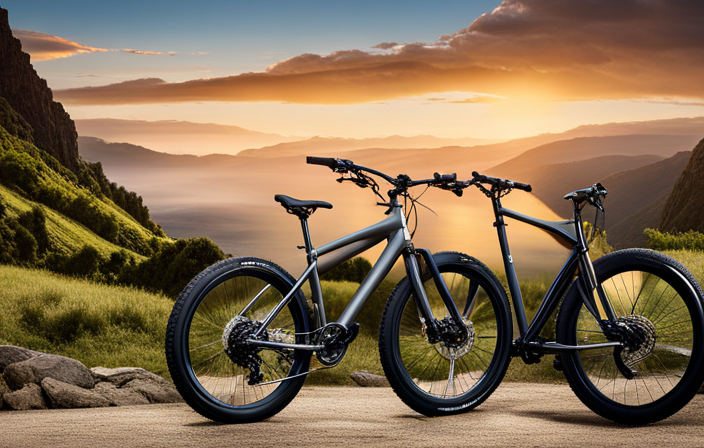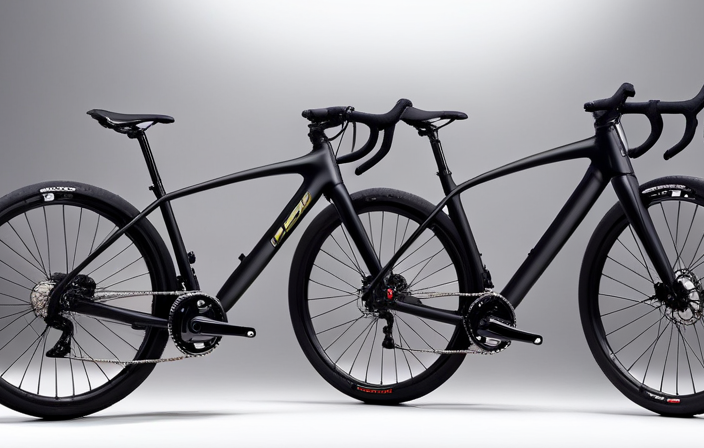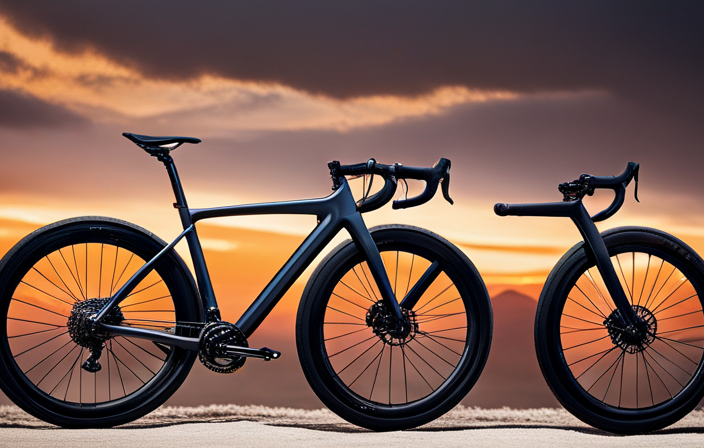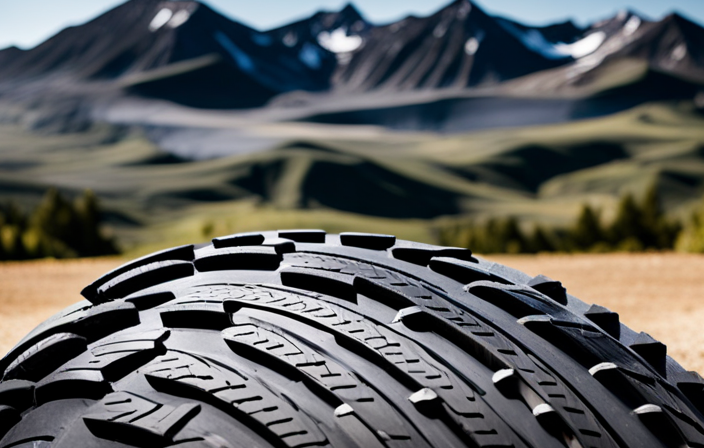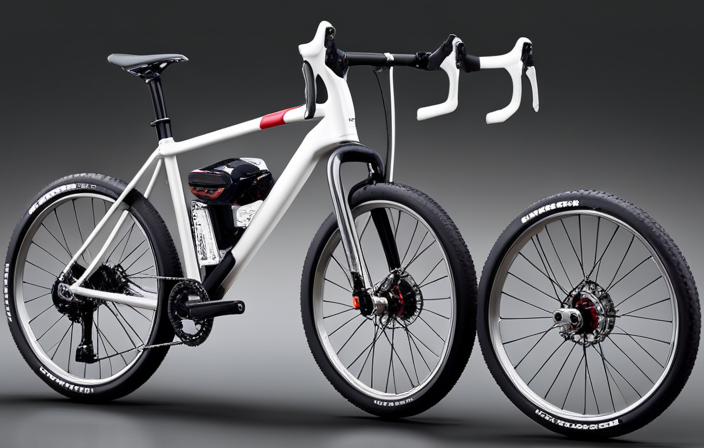Comparing the toughness of off-road cycling to the speed and adaptability of road biking, gravel bikes have become the ideal choice for adventurous riders looking to explore new horizons. With features like frame geometry, tire size, disc brakes, and gearing options, these bikes are specifically made to handle various terrains effortlessly.
Their adventure-ready features offer comfort and stability while their customization options allow riders to tailor their bike to their specific needs. In this article, we will explore what defines a gravel bike in detail, uncovering the key elements that make them stand out in the world of cycling.
Key Takeaways
- Gravel bikes have lightweight frame materials like aluminum or carbon fiber, wider handlebars with flare, and longer wheelbases with slacker head tube angles for better control, stability, and responsiveness.
- They have increased tire clearance for larger tires and improved traction, with options for customization to tailor the bike to specific needs.
- Gravel bikes have wider tires for better stability on rough surfaces and narrower tires for less rolling resistance on smoother roads. The choice of tire tread pattern affects mud and debris shedding, and tire pressure affects traction and the risk of flats.
- They are equipped with disc brakes that provide superior stopping power, consistent braking performance, and low maintenance requirements. This enhances performance and safety on gravel terrain.
Frame Geometry and Design
If you’re looking for a gravel bike, you’ll want to pay attention to the frame geometry and design. These factors play a crucial role in determining the bike’s performance on rough terrain.
First and foremost, let’s talk about frame materials. Gravel bikes are typically made from lightweight materials like aluminum or carbon fiber. These materials offer a perfect balance between durability and weight, allowing riders to tackle long-distance rides without feeling weighed down.
Next up is the gravel bike handlebars. Unlike traditional road bikes that often have drop handlebars, gravel bikes usually feature wider handlebars with flare. This design provides better control and stability when navigating unpredictable terrains. The wider grip also allows for more leverage when tackling steep climbs or descending at high speeds.
Incorporating these aspects into the overall frame geometry is essential for creating a well-balanced gravel bike. A longer wheelbase and slacker head tube angle provide stability over rough surfaces while maintaining responsiveness during quick maneuvers. Additionally, many gravel bikes come with increased tire clearance to accommodate larger tires for improved traction and comfort.
Transitioning into the subsequent section about tire size and tread, it’s important to consider how these elements work in tandem with frame geometry and design to enhance your riding experience without compromising speed or agility.
Tire Size and Tread
The tire size and tread greatly impact a gravel bike’s performance. When it comes to tire size, there is no one-size-fits-all approach. The ideal tire size for a gravel bike depends on the terrain you’ll be riding on. A wider tire provides better stability and traction on rough surfaces, while a narrower tire offers less rolling resistance on smoother roads. It’s important to find the right balance that suits your riding style and the conditions you’ll encounter.
In terms of tread, gravel bikes typically have knobby tires with deep grooves. This design allows for better grip and control when navigating loose or uneven surfaces. Additionally, the tread pattern plays a crucial role in determining how well the tires shed mud and debris.
To further enhance performance, it’s essential to consider tire pressure. Lowering the tire pressure improves traction by increasing contact with the ground, particularly on loose terrain. However, it also increases the risk of pinch flats or punctures from sharp objects.
When transitioning into the discussion about disc brakes, it’s worth noting that they work hand in hand with tires to ensure optimal stopping power and control in various conditions.
Disc Brakes
You should consider upgrading to disc brakes for better stopping power and control on your gravel adventures. Disc brakes have become increasingly popular in the world of gravel biking, and for good reason. They offer several advantages over traditional rim brakes that make them well-suited for off-road riding.
One of the key advantages of disc brakes is their superior stopping power. With a larger surface area and more direct contact with the rotor, disc brakes can provide stronger and more consistent braking performance, especially in wet or muddy conditions. This increased stopping power gives you greater control over your bike, allowing you to confidently navigate technical descents or come to a quick stop when needed.
Another benefit of disc brakes is their low maintenance requirements. Unlike rim brakes, which can wear down rims over time and require regular adjustments, disc brakes are self-contained units that are less prone to damage from debris or weather conditions. This means less time spent on maintenance and more time enjoying your gravel rides.
In conclusion, upgrading to disc brakes can greatly enhance your performance and safety on gravel terrain. With their improved stopping power and low maintenance requirements, they are a worthwhile investment for any serious gravel cyclist.
Now let’s dive into the next topic: gearing options.
Gearing Options
When it comes to gearing options on a gravel bike, there are a few key points to consider.
Firstly, having a wide range of gears is crucial for tackling both steep climbs and fast descents. This allows me to maintain an optimal cadence and keep my momentum going in any terrain.
Secondly, the compatibility with both 1x and 2x drivetrains provides flexibility depending on my riding preferences and the type of terrain I’ll be encountering.
Lastly, having the ability to switch between different gear ratios gives me more control over how I tackle various gradients and terrains, making my gravel biking experience more enjoyable and efficient.
Wide range of gears for tackling steep climbs and fast descents
For tackling steep climbs and fast descents, a gravel bike needs to have a wide range of gears. This ensures that riders can efficiently pedal up challenging inclines and maintain control during rapid descents. The wide range of gears on a gravel bike allows for smooth transitions between different terrains and gradients.
Here are four key factors to consider when evaluating the gear options on a gravel bike:
-
Frame Material: A lightweight frame material, such as carbon fiber or aluminum, can enhance overall performance by reducing weight without sacrificing strength.
-
Handlebar Options: Gravel bikes often offer multiple handlebar options, such as drop bars or flat bars. These different handlebar styles provide varying riding positions for comfort and control in diverse riding conditions.
-
Gear Ratios: Gravel bikes typically feature lower gear ratios than road bikes, allowing riders to tackle steeper climbs with ease while maintaining pedaling efficiency.
-
Drivetrain Compatibility: Gravel bikes should be compatible with both 1x and 2x drivetrains, giving riders flexibility in choosing the appropriate gearing setup based on their preferences and terrain.
In order to seamlessly transition into discussing compatibility with both 1x and 2x drivetrains, it is important to understand the various gear options available on a gravel bike.
Compatibility with both 1x and 2x drivetrains
Now that we’ve discussed the wide range of gears that are essential for tackling steep climbs and fast descents on a gravel bike, let’s shift our focus to another important aspect: compatibility with both 1x and 2x drivetrains. This feature allows riders to choose between different gear options based on their riding preferences and terrain conditions.
1x drivetrains have gained popularity in recent years due to their simplicity, lighter weight, and improved chain retention. They provide a wide range of gears without the need for a front derailleur, making them ideal for gravel riding where simplicity and reliability are key.
On the other hand, 2x drivetrains offer more gear options and finer increments between gears, allowing riders to find their optimal cadence more easily. This can be advantageous when tackling challenging terrains or when riding at higher speeds.
With this understanding of the advantages of 1x drivetrains and benefits of 2x drivetrains, we can now delve into the next section about suspension features.
Suspension Features
To better understand suspension features on gravel bikes, let’s imagine ourselves riding one and feeling how the suspension absorbs bumps and vibrations. Suspension options play a crucial role in enhancing gravel bike handling, providing a smoother and more comfortable ride over rough terrain.
Gravel bikes typically come with two types of suspension: front suspension forks and rear suspension systems.
Front suspension forks are commonly found on gravel bikes. They offer improved control and stability when tackling uneven surfaces. These forks absorb impacts from the front wheel, reducing fatigue and increasing traction. They also allow for better maneuverability by keeping the front tire in contact with the ground.
On the other hand, rear suspension systems are less common on gravel bikes but can be found on certain models designed for more technical off-road riding. These systems provide additional cushioning to absorb shocks from both wheels simultaneously, resulting in enhanced comfort and traction.
By incorporating either front or rear suspension options, manufacturers aim to optimize the performance of gravel bikes across various terrains. However, it’s important to note that not all gravel bikes come equipped with suspensions. Some riders prefer a rigid frame for better power transfer or simply don’t require added cushioning.
Transitioning into the subsequent section about ‘gravel-specific components,’ these components work together with suspension features to create a versatile and capable gravel bike suitable for any adventure.
Gravel-specific Components
Imagine yourself riding a gravel bike and experiencing the benefits of its gravel-specific components. These specialized components are designed to enhance your performance and comfort while tackling rough terrain. Here are three essential gravel bike components that make a significant difference:
-
Wide Tires: Gravel bikes typically come equipped with wider tires than traditional road bikes, usually ranging from 35mm to 45mm. This increased tire width provides better traction and stability on loose surfaces, allowing you to confidently navigate through gravel, dirt, and even mud.
-
Disc Brakes: Unlike rim brakes found on many road bikes, gravel bikes are often equipped with disc brakes. These hydraulic or mechanical disc brakes offer superior stopping power, especially in wet or muddy conditions. You’ll feel more in control when descending steep hills or navigating technical sections.
-
Flared Handlebars: Gravel-specific handlebars have a unique shape called flare or drop flare that provides a wider hand position compared to regular road handlebars. This design offers better leverage and control when riding off-road, providing stability during challenging descents and improving overall handling.
As we move into the next section about mounting points, it’s important to note that these gravel bike features contribute significantly to the versatility and performance of this type of bicycle without compromising comfort or efficiency.
Mounting Points
When it comes to mounting points on a gravel bike, there are a few key considerations.
First and foremost, having multiple bottle cage mounts is essential for longer rides where staying hydrated is crucial. These additional mounts allow me to carry extra water or even a sports drink for those hot and grueling gravel adventures.
Additionally, rack and fender mounts are important for those of us who enjoy bikepacking or commuting on our gravel bikes. These mounts provide the necessary attachment points for carrying panniers or attaching fenders, making it easier to transport gear or stay dry during wet weather conditions.
Overall, these mounting points add versatility to the gravel bike and make it more suitable for a variety of riding styles and conditions.
Multiple bottle cage mounts for longer rides
Having multiple bottle cage mounts on a gravel bike allows for longer rides without worrying about running out of water. This is especially important when considering bikepacking essentials and hydration options for extended trips. With the ability to carry multiple water bottles, I can stay hydrated throughout my journey without having to rely on finding water sources along the way. To illustrate the convenience of this feature, here is a comparison table showcasing different gravel bikes and their number of bottle cage mounts:
| Bike Model | Number of Bottle Cage Mounts |
|---|---|
| Bike A | 2 |
| Bike B | 3 |
| Bike C | 4 |
As you can see, having more bottle cage mounts provides greater flexibility in terms of carrying extra water or other fluids necessary for longer rides. Moving forward, let’s now explore the next section about rack and fender mounts for bikepacking and commuting.
Rack and fender mounts for bikepacking and commuting
If you’re planning on bikepacking or commuting, having rack and fender mounts on your gravel bike will provide you with the necessary attachment points for carrying gear and maintaining a clean ride.
These mounts allow you to easily attach racks and panniers for storing bikepacking gear, such as tents, sleeping bags, and cooking equipment.
Additionally, fender mounts ensure that mud and dirt are kept at bay during wet commutes, keeping both you and your bike cleaner.
With these attachments in place, you can confidently embark on long journeys or daily commutes knowing that your gravel bike is equipped to handle the demands of carrying extra weight and navigating various terrains.
Transitioning into the next section about versatile riding positions…
Versatile Riding Position
When it comes to gravel bikes, one of the key factors that defines them is their versatile riding position. This means that they are designed to provide a relaxed and upright riding position, which offers all-day comfort for long rides.
Additionally, this type of bike allows riders to easily switch between on-road and off-road riding, making it ideal for those who enjoy exploring different terrains.
Overall, the versatile riding position of a gravel bike enhances the overall experience by prioritizing comfort and adaptability.
Relaxed and upright riding position for all-day comfort
The relaxed and upright riding position of a gravel bike provides all-day comfort. With versatile handlebar options and padded saddle options, riders can customize their position for optimum comfort on long rides.
The upright riding position helps to reduce strain on the neck, shoulders, and lower back, allowing riders to stay comfortable for extended periods of time. This is especially important when tackling rough terrain or long distances.
The wide handlebars provide stability and control, while the padded saddle absorbs shock and reduces pressure points. Whether I’m cruising along a smooth road or navigating through challenging off-road trails, the relaxed position of a gravel bike keeps me comfortable throughout my ride.
Being able to switch seamlessly between on-road and off-road riding is a key feature that makes gravel bikes so versatile and enjoyable to ride.
Ability to switch between on-road and off-road riding
Switching seamlessly between on-road and off-road riding is a key feature that makes gravel bikes versatile and enjoyable to ride. Gravel bikes are designed to handle different surfaces with ease, allowing riders to transition effortlessly from smooth pavement to rugged trails.
The versatility in terrain is enhanced by a combination of factors. First, the wider tires provide better traction and stability on loose surfaces like gravel or dirt. Second, the geometry of the bike ensures a balanced and controlled ride, whether you’re speeding down a road or navigating through rocky terrain. Lastly, the added clearance for larger tires allows for increased comfort and control when encountering obstacles such as potholes or tree roots.
This ability to switch between different surfaces gives riders the freedom to explore new routes and enjoy the thrill of off-road adventures.
Transitioning into the subsequent section about ‘durable construction’, it’s important to note that these features go hand-in-hand with the robust build of gravel bikes.
Durable Construction
A key aspect of a gravel bike is its durable construction. When it comes to gravel riding, you need a bike that can withstand the demands of off-road terrain and rough conditions. One important factor in the durability of a gravel bike is its frame material.
Most gravel bikes are made from aluminum or carbon fiber, which are both lightweight and strong materials. Aluminum frames are known for their durability and affordability, while carbon fiber frames offer the advantage of being lighter and more responsive.
In addition to frame material, another aspect of durable construction is the ability to handle custom paint jobs. Many gravel bike enthusiasts like to personalize their ride with unique paint schemes and designs. A gravel bike with durable construction should be able to accommodate these customizations without compromising its integrity.
Overall, a gravel bike’s durable construction ensures that it can handle the challenges of both on-road and off-road riding. It provides the rider with confidence and peace of mind knowing that their bike can withstand whatever terrain they encounter.
In the next section, we will explore another important aspect of a gravel bike: its compatibility with gravel-specific accessories such as wider tires and fenders.
Gravel-specific Accessories
When it comes to gravel biking, having the right accessories can greatly enhance your riding experience.
Two essential accessories for bikepacking are frame bags and saddle packs, which provide ample storage space for all your essentials while on the go.
Additionally, flap guards and mudguards are crucial for protecting you and your bike from dirt and debris, ensuring a cleaner and more enjoyable ride.
Frame bags and saddle packs for storage during bikepacking
Don’t forget to bring frame bags and saddle packs for storage during your bikepacking trip. These bikepacking gear essentials provide convenient storage solutions for all your necessary items.
Frame bags are designed to fit snugly within the triangle of your bike’s frame, allowing you to carry tools, spare parts, and other small necessities.
Saddle packs, on the other hand, attach securely beneath your seat and offer ample space for larger items like clothing or camping gear. Both options allow you to distribute weight evenly across your bike, ensuring optimal balance and stability while riding off-road terrain.
Once you have packed all your essentials into these storage solutions, you can move on to considering flap guards and mudguards for protection from dirt and debris on the trail.
Flap guards and mudguards for protection from dirt and debris
To protect yourself from dirt and debris while riding off-road, make sure you attach flap guards and mudguards to your bike.
Flap guards are a popular choice for gravel biking due to their lightweight and flexible nature. They are typically made of durable materials such as rubber or plastic, designed to prevent dirt and water from splashing onto the rider’s backside.
Mudguards, on the other hand, offer more comprehensive protection by covering both the front and rear wheels. They are usually made of sturdy materials like aluminum or carbon fiber, providing excellent durability and resistance against rough terrains.
While both options have their advantages, flap guards are preferred by many gravel bikers for their simplicity and ease of installation. They provide adequate coverage without adding unnecessary weight or compromising maneuverability.
With these protective attachments in place, you can confidently navigate through muddy trails without worrying about getting covered in dirt or damaging your components.
Transitioning into the subsequent section about ‘all-terrain capability’, it is important to consider not only protection but also the overall performance of a gravel bike in various off-road conditions.
All-terrain Capability
You can easily ride on various types of terrain with a gravel bike. Gravel bikes are designed for adventure riding and off-road exploration, making them perfect for those who love to explore the great outdoors. With their wide tires and sturdy frame, gravel bikes provide excellent stability and control on all kinds of surfaces. Whether you’re tackling rocky trails, muddy paths, or even sandy beaches, a gravel bike can handle it all.
Here are three reasons why a gravel bike is perfect for all-terrain capability:
-
Versatile Tires: Gravel bikes are equipped with wider tires that offer increased traction and stability on uneven surfaces. These tires can easily navigate through loose gravel, dirt roads, and even grassy fields.
-
Robust Frame: The frame of a gravel bike is built to withstand the rigors of off-road riding. It provides enough clearance for larger tires and features durable construction that can handle rough terrains without any issues.
-
Responsive Handling: Gravel bikes are designed to be nimble and responsive, allowing riders to maneuver through tight corners and technical sections with ease. This makes them ideal for navigating challenging terrains.
With its all-terrain capability, a gravel bike is ready to take you on any adventure you desire. In the next section, we will explore the various adventure-ready features that make these bikes perfect for off-road exploration.
Adventure-ready Features
Get ready to experience the great outdoors and explore off-road terrains with a gravel bike’s adventure-ready features. One of the key aspects that make a gravel bike perfect for any adventure is its customizability. These bikes are designed to be versatile, allowing riders to tailor them according to their preferences. From choosing different frame sizes and materials to adjusting handlebar height and saddle position, you can truly make your gravel bike your own.
In addition to customizability, all-day comfort is another feature that sets these bikes apart. Gravel rides can often last for hours, so it’s crucial to have a bike that keeps you comfortable throughout the journey. Gravel bikes typically come with wider tires and relaxed geometry, which provide better shock absorption and stability on rough terrains.
Transitioning into the next section about comfort and stability, it’s important to note that these two factors go hand in hand when it comes to gravel biking. With their adventure-ready features like customizability and all-day comfort, gravel bikes offer unparalleled stability on various surfaces, ensuring a smooth ride even in challenging conditions.
Now let’s dive deeper into how these bikes excel in providing both comfort and stability during your off-road explorations.
Comfort and Stability
In my previous discussion about adventure-ready features, I highlighted the importance of components like tire clearance, frame geometry, and mounting points for bikepacking accessories. Now, let’s delve into another crucial aspect that defines a gravel bike: comfort and stability.
When it comes to gravel riding, finding the right balance between comfort and speed is essential. Gravel bikes are designed to handle rough terrain while still providing a smooth and enjoyable ride experience. With their relaxed geometry and wider tires, these bikes offer excellent shock absorption, reducing fatigue on long rides.
Furthermore, handling and maneuverability play a significant role in the overall performance of a gravel bike. The combination of a slack head tube angle and longer wheelbase ensures stability at high speeds while maintaining responsiveness in technical sections. This allows riders to confidently navigate through uneven surfaces without compromising control.
As an avid gravel rider myself, I appreciate how these characteristics contribute to a more enjoyable riding experience. However, comfort and stability are not the only defining factors; off-road performance is equally important. So let’s now explore how gravel bikes excel in tackling challenging terrains with their exceptional off-road capabilities…
Off-road Performance
When it comes to off-road performance, a stiffer frame and fork are essential for efficient power transfer. This means that each pedal stroke is maximized, allowing me to tackle rough terrain with ease.
Additionally, a wide gear range is crucial for navigating steep and technical trails. With the ability to shift into lower gears, I can conquer challenging climbs and maintain control on descents.
Stiffer frame and fork for efficient power transfer
The stiffer frame and fork on a gravel bike allow for more efficient power transfer. The frame material plays a crucial role in achieving this. Most gravel bikes are made from materials like carbon fiber or aluminum, which offer a combination of stiffness and lightness. This stiffness ensures that the energy I put into pedaling is transferred directly to the wheels, without any loss due to flexing or bending of the frame. It also helps in maintaining stability and control when traversing rough terrains.
In addition to the frame, the fork also contributes to power transfer efficiency. A stiffer fork enhances steering precision and responsiveness, ensuring that my inputs are translated accurately into changes in direction. This becomes especially important when tackling technical terrain or making quick maneuvers.
As I transition into discussing the next subtopic about wide gear range for tackling steep and technical terrain, it’s worth noting that an efficient power transfer is just one aspect of a gravel bike’s off-road performance capabilities.
Wide gear range for tackling steep and technical terrain
Achieving a wide gear range is essential for conquering steep and technical terrain. When it comes to gravel bike maintenance, choosing the right gear ratios is crucial. The ability to shift into lower gears allows you to climb with ease, while higher gears enable you to maintain speed on flat sections or descents. A wider gear range gives you the flexibility to tackle any type of terrain that comes your way. Whether you’re facing a steep incline or navigating through rocky trails, having the right gear ratios ensures efficient power transfer and optimal performance.
To help illustrate the importance of a wide gear range, consider the following table:
| Gear Ratio | Terrain Type |
|---|---|
| Low | Steep hills |
| Medium | Technical sections |
| High | Flat surfaces |
As shown in the table above, each gear ratio corresponds to a specific terrain type, allowing you to adapt your riding style accordingly.
When it comes to customization options for your gravel bike, there are numerous ways to enhance its performance without taking an additional step.
Customization Options
When it comes to customization options, I love the ability to personalize my gravel bike with different colors and accessories. It allows me to make my bike truly unique and reflective of my personal style.
Additionally, the compatibility with various bikepacking setups and equipment is a game-changer. This means that no matter where I want to go or what gear I need to carry, my bike can handle it all.
Ability to personalize the bike with different colors and accessories
One way to personalize a gravel bike is by adding different colors and accessories. Personalization options for gravel bikes are abundant, allowing riders to customize their bikes according to their preferences and style.
When it comes to colors, there are usually multiple options available, ranging from bold and vibrant hues to more subtle and understated tones. This allows riders to choose a color that reflects their personality or matches their other gear.
Additionally, gravel bikes offer a wide array of accessory choices, such as racks, fenders, bags, lights, and bottle cages. These accessories not only enhance the functionality of the bike but also allow riders to tailor it specifically for their needs and riding conditions. Moreover, they can further enhance the aesthetic appeal of the bike while providing practical benefits.
Moving forward into the discussion on compatibility with various bikepacking setups and equipment…
Compatibility with various bikepacking setups and equipment
To make sure your gravel bike is compatible with different bikepacking setups and equipment, you can explore options that allow for easy attachment and secure mounting of bags, racks, and other gear.
When it comes to bikepacking gear, having a bike that can accommodate various attachments is essential. Look for frame features such as multiple braze-ons or eyelets that provide plenty of options for attaching racks and bags. Additionally, consider the compatibility of your fork with front-mounted bags or racks.
A bike with ample tire clearance will also be advantageous, allowing you to use larger tires for off-road adventures while still leaving enough room for additional gear. Furthermore, check if the seat post has mounting points to attach a saddlebag securely.
By ensuring your gravel bike has these compatibility features, you can confidently embark on any bikepacking adventure knowing your equipment will stay securely in place.
Frequently Asked Questions
Can a gravel bike be used for road cycling as well?
Yes, a gravel bike can definitely be used for road cycling as well.
While a gravel bike is specifically designed for off-road riding on gravel or dirt roads, it shares many features with road bikes. It has a similar frame geometry, drop handlebars, and lightweight construction.
Additionally, most gravel bikes have the capability to mount slick tires that are ideal for smooth road surfaces.
So, whether you’re tackling rough terrains or enjoying a leisurely road biking session, a gravel bike is versatile enough to handle both scenarios.
What kind of terrain is a gravel bike suitable for?
Gravel bikes have gained immense popularity in recent years, and for good reason. Did you know that gravel bike sales increased by 60% from 2019 to 2020?
These versatile machines are suitable for a variety of terrains, including gravel roads, dirt trails, and even pavement. While they share similarities with mountain bikes, gravel bikes are designed specifically for endurance and comfort on longer rides.
Their wider tires provide stability and traction on rough surfaces compared to traditional road bikes.
Are gravel bikes suitable for long-distance touring?
Gravel bikes are indeed suitable for long-distance touring on various terrains. With their versatile features, they excel in providing a comfortable and efficient ride over extended distances.
Gravel bike features such as wider tires for stability and grip, endurance-focused geometry for comfort, and additional mounting points for racks and panniers make them ideal for carrying gear during tours.
Their durability, reliability, and ability to handle diverse road conditions make gravel bikes an excellent choice for long-distance touring adventures.
Can a gravel bike be used for cyclocross racing?
As the saying goes, ‘Jack of all trades, master of none.’
While a gravel bike can handle various terrains and long-distance touring, using it for cyclocross racing may not be ideal. Compared to a mountain bike, a gravel bike lacks the aggressive geometry and suspension needed for intense off-road racing.
However, its versatility and lighter weight can offer advantages in terms of speed and maneuverability.
Ultimately, it boils down to personal preference and the specific demands of the cyclocross course.
What is the average weight of a gravel bike?
The average weight of a gravel bike depends on the quality of its components. Generally, a well-made gravel bike can weigh anywhere between 20 to 25 pounds. Lightweight frames made of materials like carbon fiber contribute to reducing the overall weight.
However, it’s important to note that the weight can vary depending on specific build configurations and customization options. A lighter bike is preferred for improved maneuverability and efficiency during off-road adventures.
Conclusion
In conclusion, a gravel bike is more than just a bicycle. It is a versatile steed that combines the best elements of road and mountain bikes to conquer any terrain. With its unique frame geometry, larger tire size, and disc brakes, it offers stability and control on rough surfaces. The wide range of gearing options allows for effortless climbing or speedy descents.
Additionally, its adventure-ready features and customization options make it the perfect companion for exploring new horizons. So hop on your gravel bike and let it be your wings to fly through uncharted paths in search of endless possibilities.
Figure of speech: ‘let it be your wings to fly’ – This figure of speech conveys the deeper meaning that a gravel bike can provide freedom and liberation, enabling riders to go beyond their limits and explore new territories with ease.
